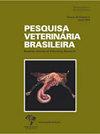Pathomorphological and molecular investigations in naturally infected Chukar partridges (Alectoris Chukar) with Histomonas meleagridis and Tetratrichomonas gallinarum
IF 0.8
4区 农林科学
Q3 VETERINARY SCIENCES
引用次数: 0
Abstract
ABSTRACT: Histomonas meleagridis and Tetratrichomonas gallinarum are two protozoans responsible for mortality associated with typhlohepatitis in poultry. In this study, the etiology of high mortality in Chukar partridges suspected of infection with these agents was investigated pathologically and molecularly. Twelve healthy partridges during the laying period and 30 partridges that died due to disease and were included in the study. In blood analysis, increased levels of WBC, NEU, LYM, MONO, EO and BASO suggesting bacterial and/or parasitic infection; decreased levels of HGB, MCH and MCHC, which are markers of anemia; and increased AST and LDH levels, which are important for liver degenerations. In the liver, which is one of the most pathologically affected organs, multifocal necrosis foci that sometimes merge with each other and spread to large areas, and severe fibrino-necrotic typhlitis were detected. There was amyloid deposition in the space of Disse and vascular sinuses in the liver. PAS positive protozoal agents were observed in and around the lesioned areas. By PCR analyzes using specific primers, 11 of the samples were positive for H. meleagridis only, whereas 5 were positive for T. gallinarum only; 14 samples tested positive for both agents. Sequence analysis showed 100% identity between all samples resulting in positive PCR. In addition, Escherichia coli was produced in microbiological culture (27 of 30). When all the results were evaluated together, it was concluded that H. meleagridis and T. gallinarum and secondary E. coli may cause high mortality in partridges under lay stress.自然感染肉鸡组织单胞菌和鸡四毛单胞菌的楚卡鹧鸪的病理形态学和分子研究
摘要:肉鸡组织单胞菌和鸡四毛单胞菌是导致家禽伤寒肝炎死亡的两种原生动物。本研究对怀疑感染这些病原体的楚卡鹧鸪高死亡率的病因进行了病理和分子研究。选取12只产蛋期健康的鹌鹑和30只因病死亡的鹌鹑作为研究对象。在血液分析中,WBC、NEU、LYM、MONO、EO和BASO水平升高提示细菌和/或寄生虫感染;HGB、MCH和MCHC水平下降,这是贫血的标志;AST和LDH水平升高,这对肝脏变性很重要。肝脏是病理上受影响最严重的器官之一,可发现多灶性坏死灶,有时相互合并并大面积扩散,严重的纤维蛋白坏死性斑疹伤寒。肝间隙及血管窦内可见淀粉样蛋白沉积。病变部位内及周围可见PAS阳性原虫。利用特异引物进行PCR分析,11份样品仅为肉苁苁菌阳性,5份样品仅为肉苁菌阳性;14个样本对这两种药剂检测呈阳性。序列分析显示,所有样品的同源性为100%,PCR阳性。此外,在微生物培养中产生了大肠杆菌(27 / 30)。综上所述,肉鸡肉鸡嗜血杆菌、鸡肉鸡嗜血杆菌和继发性大肠杆菌可能是产蛋应激下鹌鹑死亡率较高的原因。
本文章由计算机程序翻译,如有差异,请以英文原文为准。
求助全文
约1分钟内获得全文
求助全文
来源期刊

Pesquisa Veterinaria Brasileira
农林科学-兽医学
CiteScore
1.30
自引率
16.70%
发文量
41
审稿时长
9-18 weeks
期刊介绍:
Pesquisa Veterinária Brasileira - Brazilian Journal of Veterinary Research (http://www.pvb.com.br), edited by the Brazilian College of Animal Pathology in partnership with the Brazilian Agricultural Research Organization (Embrapa) and in collaboration with other veterinary scientific associations, publishes original papers on animal diseases and related subjects. Critical review articles should be written in support of original investigation. The editors assume that papers submitted are not being considered for publication in other journals and do not contain material which has already been published. Submitted papers are peer reviewed.
The abbreviated title of Pesquisa Veterinária Brasileira is Pesqui. Vet. Bras.
 求助内容:
求助内容: 应助结果提醒方式:
应助结果提醒方式:


